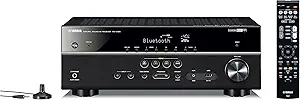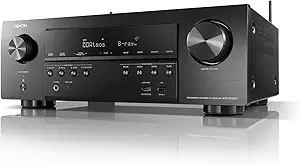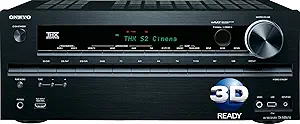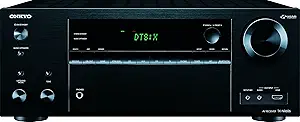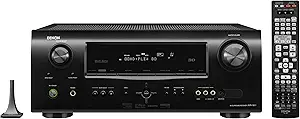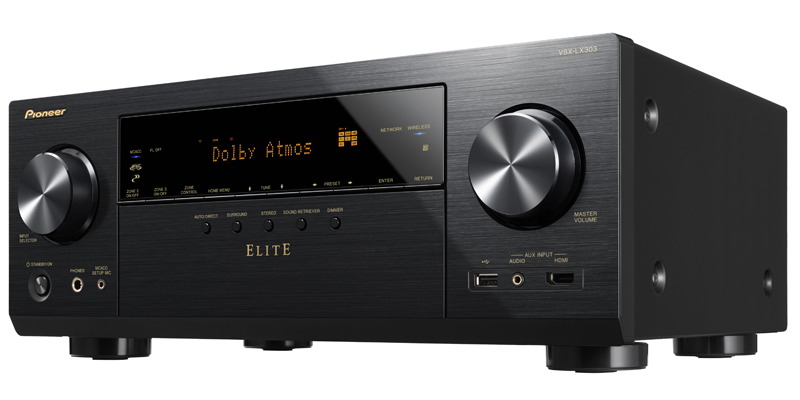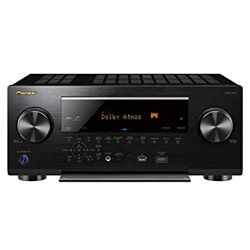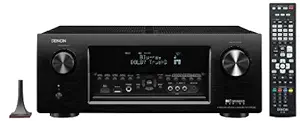YAMAHA RX-V385 5.1-Channel 4K Ultra HD AV Receiver with Bluetooth VS
Yamaha RX-V485
Pros & Cons
YAMAHA RX-V385 5.1-Channel 4K Ultra
VSPros
- It is compatible with modern devices, like a new TCL 4K TV (a 2018 year model).
- Awesome quality and great premium quality sound, I approve.
- The setup is very easy and simple.
- You can stream content from a phone or a tablet via Bluetooth.
Cons
- You cannot use the Bluetooth module with two different devices at the same time.
- Some buyers have reported echoing issues.
- The USB port does not work with the iPod.
Yamaha RX-V485
VSPros
- The possibility of using a two-amplified configuration.
- Voice control Amazon Alexa.
- Installation with ease.
- Wires are conveniently hidden in the front column.
Cons
- Remote feels a bit cheap, and the directional buttons are recessed enough, so it is very inconvenient.
Specifications
Groups
| Specification | YAMAHA RX-V385 5.1-Channel 4K Ultra | Yamaha RX-V485 |
|---|---|---|
| Connector Type | ||
| Phones | 1 | 1 |
| Optical Digital Inputs | 1 | 1 |
| Usb | 1 | 1 |
| Av Inputs | has not | has not |
| Subwoofer Outputs | 1 | 1 |
| Coaxial Digital Outputs | has not | has not |
| Optical Digital Outputs | has not | has not |
| Hdmi Outputs | 1 | 1 |
| Hdmi Inputs | 4 | 4 |
| Coaxial Digital Inputs | 2 | 2 |
| Additional Features | ||
| Three-zone Capability | ||
| Smartphone Remote Control | ||
| Mcacc Pro | - | |
| A-b Speaker Switch | ||
| Dual-zone Capability | ||
| Pure Direct Mode | ||
| Auto Power Off | ||
| Bi-amplifying | ||
| Audio Return Channel (arc) | ||
| Air Studios Monitor Certification | - | |
| Apple Air-play Support | ||
| X.v.color | - | |
| Advanced Sound Retriever (asr) Technology | ||
| Deep Color | - | |
| Functions | ||
| Network Audio Player | ||
| Internet Radio | ||
| Digital Player | ||
| Amplifier Class | - | |
| Power Device | ||
| Standby Power Consumption | 0.3 W | 0.15 W |
| Operational Power Consumption | 220 W | 240 W |
| Built-in Decoders | ||
| Dts:x | ||
| Dts Neural:x | - | |
| Dts-hd Master Audio | - | |
| Dolby True Hd | ||
| Dolby Surround | ||
| Dolby Digital Plus | ||
| Dolby Atmos | ||
| Connectivity Interfaces | ||
| Wi-fi | ||
| Bluetooth | ||
| Ieee 802.3u | ||
| Ieee 802.3 | ||
| Audio Formats | ||
| Wma | ||
| Wav | ||
| Mp3 | ||
| Flac | ||
| Dsd | - | |
| Apple Lossless | ||
| Aiff | ||
| Aac | ||
| Radio | ||
| Preset Station Qty | 40 | - |
| Preset Station | 40 | 40 |
| Tuner Bands | AM/FM | AM/FM |
| Tuner Type | digital | digital |
| Clock | ||
| Sleep Timer | ||
| Built-in Clock | ||
| Built-in Display | ||
| Colour | black | black |
| Type | fluorescent | fluorescent |
| Sound Features | ||
| Digital Sound Processor (dsp) | - | |
| Sound Output Mode | SURROUND | - |
| Digital Content Protection | HDCP 2.2 | HDCP 2.2 |
| Dsp Preset Qty | Virtual CINEMA DSP | - |
| Surround System Class | 5.1 channel | 5.1 channel |
| Surround Sound Effects | Cinema DSP, Virtual Cinema Front | Cinema DSP 3D |
| Audio D/a Converter | 24 bit / 192 kHz | 24bit / 192kHz |
| Signal Processing | ||
| Upscaling Via Hdmi | up to 4K | up to 4K |
| 3d Pass-through | ||
| Video Conversion/scaling | HDMI to HDMI scaling, analog to HDMI up conversion | HDMI to HDMI scaling, analog to HDMI up conversion |
| Hdmi Pass-through | up to 4K | up to 4K |
| Amplifier | ||
| Total Harmonic Distortion | 0.09 % | 0.09 % |
| Frequency Response | 20 Hz - 20 kHz | 20 Hz-20 kHz |
| Output Impedance Per Channel | 6 Ohm | 6 Ohm |
| Output Power Per Channel | 70 W | 80 W |
| Total Output Power | 350 W | 400 W |
| Media Content Source | ||
| Usb-host | ||
| Network | ||
| Bluetooth | ||
| Dimensions | ||
| Dimensions | 12.4 x 17.1 x 6.3 inches | 12.4 x 17.1 x 6.3 inches |
| User Manual | ||
| Manual | rx-v385bl.pdf | rx-v485.pdf |
| General | ||
| Item Color | Black | - |
| Brand | YAMAHA | Yamaha |
| Dimension | ||
| Item Dimension | 12.4 x 17.13 x 6.34 inches | - |
| Item Weight | 16.3 pounds | - |

